Monday, June 15, 2020
“For the first thirty years of its history, Columbia was known as King’s College.”
— History of the University Identity
Hence the crown favicon—

“When people talk about the importance of the study of ‘symmetry’
in mathematics, physics, and elsewhere, they often make the mistake
of only paying attention to the symmetry groups. The structure you
actually have is not just a group (the abstract ‘symmetries’), but an
action of that group on some other object, the thing that has symmetries.”
— Peter Woit of Columbia on June 9, reviewing a Quanta Magazine article
* From earlier posts in this journal containing the title phrase.
Comments Off on “The Thing and I” Continues*
Saturday, May 23, 2020
"MIT professor of linguistics Wayne O’Neil died on March 22
at his home in Somerville, Massachusetts."
— MIT Linguistics, May 1, 2020

The "deep structure" above is the plane cutting the cube in a hexagon
(as in my note Diamonds and Whirls of September 1984).
See also . . .

Comments Off on Structure for Linguists
Thursday, May 14, 2020

|
Saturday, September 17, 2016
|
For those who prefer comedy —

Other toys: Archimedes at Hiroshima and related posts.
Comments Off on For Mask Aficionados
Friday, May 1, 2020
The following passage is from Amanda Gefter’s Trespassing
on Einstein’s Lawn (Bantam Books, 2014).
| “You know the story of Plato’s cave?” my father asked. “All the prisoners are chained up in the cave and they can’t see the real world outside, only the shadows on the wall? That’s supposed to be a negative thing, like they’ll never know reality. But the truth is, you have to be stuck inside a limited reference frame for there to be any reality at all! If you weren’t chained to your light cone, you’d see nothing. The H-state.”
I nodded. “You’d have no information. You need the broken symmetry, the shadow, to have information and information gives rise to the world. It from bit.”
I couldn’t help but grin with excitement. The message was clear: having a finite frame of reference creates the illusion of a world, but even the reference frame itself is an illusion. Observers create reality, but observers aren’t real. There is nothing ontologically distinct about an observer, because you can always find a frame in which that observer disappears: the frame of the frame itself, the boundary of the boundary.
“If physicists discover an invariant someday, the game will be up,” my father mused. “That would rule out the hypothesis that the universe is really nothing.”
That was true. But so far, at least, every last invariant had gone the way of space and time, rendered relative and observer-dependent. Spacetime, gravity, electromagnetism, the nuclear forces, mass, energy, momentum, angular momentum, charge, dimensions, particles, fields, the vacuum, strings, the universe, the multiverse, the speed of light— one by one they had been downgraded to illusion. As the surface appearance of reality fell away, only one thing remained. Nothing. |
My path to Gefter’s father’s musing led from a quotation attributed,
probably falsely, to John Archibald Wheeler on page 52 of Octavio
Paz’s Claude Lévi-Strauss: An Introduction (Cornell, 1970) —
“There is a point at which
‘something is nothing and nothing is something.’ “
The quote may actually be by AP writer John Barbour reporting
on a 1967 American Physical Society talk by Wheeler, “The End
of Time.”
Gefter mentions Wheeler 369 times:

See as well Introduction to Quantum Woo.
Comments Off on Bullshit Studies
Wednesday, April 29, 2020
For an account by R. T. Curtis of how he discovered the Miracle Octad Generator,
see slides by Curtis, “Graphs and Groups,” from his talk on July 5, 2018, at the
Pilsen conference on algebraic graph theory, “Symmetry vs. Regularity: The first
50 years since Weisfeiler-Leman stabilization” (WL2018).
See also “Notes to Robert Curtis’s presentation at WL2018,” by R. T. Curtis.
Meanwhile, here on July 5, 2018 —
| Simultaneous perspective does not look upon language as a path because it is not the search for meaning that orients it. Poetry does not attempt to discover what there is at the end of the road; it conceives of the text as a series of transparent strata within which the various parts—the different verbal and semantic currents—produce momentary configurations as they intertwine or break apart, as they reflect each other or efface each other. Poetry contemplates itself, fuses with itself, and obliterates itself in the crystallizations of language. Apparitions, metamorphoses, volatilizations, precipitations of presences. These configurations are crystallized time: although they are perpetually in motion, they always point to the same hour—the hour of change. Each one of them contains all the others, each one is inside the others: change is only the oft-repeated and ever-different metaphor of identity.
— Paz, Octavio. The Monkey Grammarian
(Kindle Locations 1185-1191).
Arcade Publishing. Kindle Edition. |
The 2018 Log24 post containing the above Paz quote goes on to quote
remarks by Lévi-Strauss. Paz’s phrase “series of transparent strata”
suggests a review of other remarks by Lévi-Strauss in the 2016 post
“Key to All Mythologies.“

Comments Off on Curtis at Pilsen, Thursday, July 5, 2018
Wednesday, April 8, 2020

Click the ring for Pierre Cartier on the barber of Seville
and “The evolution of concepts of space and symmetry.”
Comments Off on Follow the Ring
Saturday, March 7, 2020
From "Mathieu Moonshine and Symmetry Surfing" —
(Submitted on 29 Sep 2016, last revised 22 Jan 2018)
by Matthias R. Gaberdiel (1), Christoph A. Keller (2),
and Hynek Paul (1)
(1) Institute for Theoretical Physics, ETH Zurich
(2) Department of Mathematics, ETH Zurich
https://arxiv.org/abs/1609.09302v2 —
"This presentation of the symmetry groups Gi is
particularly well-adapted for the symmetry surfing
philosophy. In particular it is straightforward to
combine them into an overarching symmetry group G
by combining all the generators. The resulting group is
the so-called octad group
G = (Z2)4 ⋊ A8 .
It can be described as a maximal subgroup of M24
obtained by the setwise stabilizer of a particular
'reference octad' in the Golay code, which we take
to be O9 = {3,5,6,9,15,19,23,24} ∈ 𝒢24. The octad
subgroup is of order 322560, and its index in M24
is 759, which is precisely the number of
different reference octads one can choose."
This "octad group" is in fact the symmetry group of the affine 4-space over GF(2),
so described in 1979 in connection not with the Golay code but with the geometry
of the 4×4 square.* Its nature as an affine group acting on the Golay code was
known long before 1979, but its description as an affine group acting on
the 4×4 square may first have been published in connection with the
Cullinane diamond theorem and Abstract 79T-A37, "Symmetry invariance in a
diamond ring," by Steven H. Cullinane in Notices of the American Mathematical
Society , February 1979, pages A-193, 194.
* The Galois tesseract .
Update of March 15, 2020 —
Conway and Sloane on the "octad group" in 1993 —

Comments Off on The “Octad Group” as Symmetries of the 4×4 Square
Thursday, February 20, 2020
… An abstract artist who reportedly died at 93 yesterday.


A search in this journal for Shubnikov yields…
"Raiders of the Lost Stone" (December 26, 2017).
Comments Off on In Memory of Jack Youngerman…
Saturday, February 15, 2020

"… And the song of love's recision . . . ." — E. L. Doctorow
Comments Off on Invisible Laws
Tuesday, January 28, 2020
Two of the thumbnail previews
from yesterday's 1 AM post …
"Hum a few bars"

"For 6 Prescott Street"

Further down in the "6 Prescott St." post, the link 5 Divinity Avenue
leads to …
|
A Letter from Timothy Leary, Ph.D., July 17, 1961
Harvard University
Department of Social Relations
Center for Research in Personality
Morton Prince House
5 Divinity Avenue
Cambridge 38, Massachusetts
July 17, 1961
Dr. Thomas S. Szasz
c/o Upstate Medical School
Irving Avenue
Syracuse 10, New York
Dear Dr. Szasz:
Your book arrived several days ago. I've spent eight hours on it and realize the task (and joy) of reading it has just begun.
The Myth of Mental Illness is the most important book in the history of psychiatry.
I know it is rash and premature to make this earlier judgment. I reserve the right later to revise and perhaps suggest it is the most important book published in the twentieth century.
It is great in so many ways–scholarship, clinical insight, political savvy, common sense, historical sweep, human concern– and most of all for its compassionate, shattering honesty.
. . . .
|
The small Morton Prince House in the above letter might, according to
the above-quoted remarks by Corinna S. Rohse, be called a "jewel box."
Harvard moved it in 1978 from Divinity Avenue to its current location at
6 Prescott Street.
Related "jewel box" material for those who
prefer narrative to mathematics —
"In The Electric Kool-Aid Acid Test , Tom Wolfe writes about encountering
'a young psychologist,' 'Clifton Fadiman’s nephew, it turned out,' in the
waiting room of the San Mateo County jail. Fadiman and his wife were
'happily stuffing three I-Ching coins into some interminable dense volume*
of Oriental mysticism' that they planned to give Ken Kesey, the Prankster-
in-Chief whom the FBI had just nabbed after eight months on the lam.
Wolfe had been granted an interview with Kesey, and they wanted him to
tell their friend about the hidden coins. During this difficult time, they
explained, Kesey needed oracular advice."
— Tim Doody in The Morning News web 'zine on July 26, 2012**
Oracular advice related to yesterday evening's
"jewel box" post …
A 4-dimensional hypercube H (a tesseract ) has 24 square
2-dimensional faces. In its incarnation as a Galois tesseract
(a 4×4 square array of points for which the appropriate transformations
are those of the affine 4-space over the finite (i.e., Galois) two-element
field GF(2)), the 24 faces transform into 140 4-point "facets." The Galois
version of H has a group of 322,560 automorphisms. Therefore, by the
orbit-stabilizer theorem, each of the 140 facets of the Galois version has
a stabilizer group of 2,304 affine transformations.
Similar remarks apply to the I Ching In its incarnation as
a Galois hexaract , for which the symmetry group — the group of
affine transformations of the 6-dimensional affine space over GF(2) —
has not 322,560 elements, but rather 1,290,157,424,640.
* The volume Wolfe mentions was, according to Fadiman, the I Ching.
** See also this journal on that date — July 26, 2012.
Comments Off on Very Stable Kool-Aid
Wednesday, January 22, 2020

From Wallace Stevens, "The Man with the Blue Guitar":
IX
And the color, the overcast blue
Of the air, in which the blue guitar
Is a form, described but difficult,
And I am merely a shadow hunched
Above the arrowy, still strings,
The maker of a thing yet to be made . . . .

"Arrowy, still strings" from the diamond theorem
Comments Off on Gap Dance
Friday, December 13, 2019

(Adapted from Encyclopaedia Britannica,
Eleventh Edition (1911), Crystallography .)
Comments Off on Apollo’s 13 Revisited
Monday, November 11, 2019

The misleading image at right above is from the cover of
an edition of Charles Williams's classic 1931 novel
Many Dimensions published in 1993 by Wm. B. Eerdmans.
Compare and constrast —
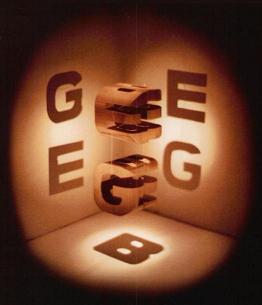
Cover of a book by Douglas Hofstadter

An Invariance of Symmetry
Comments Off on Time and Chance
Tuesday, October 22, 2019
The production-company logos for Carpenter B and Bad Robot
in end credits for a 2016 TV mini-series based on the Stephen King
novel 11/22/63 suggest a look at . . .

For the Church of Synchronology —
This weblog on Aug. 11, 2017:
Symmetry's Lifeboat and Archimedes for Jews.
Comments Off on Logos
Friday, October 11, 2019
John Horgan in Scientific American magazine on October 8, 2019 —
"In the early 1990s, I came to suspect that the quest
for a unified theory is religious rather than scientific.
Physicists want to show that all things came from
one thing: a force, or essence, or membrane
wriggling in eleven dimensions, or something that
manifests perfect mathematical symmetry. In their
search for this primordial symmetry, however,
physicists have gone off the deep end . . . ."
Other approaches —
See "Story Theory of Truth" in this journal and, from the November 2019
Notices of the American Mathematical Society . . .
|
Story Driven
More fundamental than the label of mathematician is that of human. And as humans, we’re hardwired to use stories to make sense of our world (story-receivers) and to share that understanding with others (storytellers) [2]. Thus, the framing of any communication answers the key question, what is the story we wish to share? Mathematics papers are not just collections of truths but narratives woven together, each participating in and adding to the great story of mathematics itself.
The first endeavor for constructing a good talk is recognizing and choosing just one storyline, tailoring it to the audience at hand. Should the focus be on a result about the underlying structures of group actions? . . . .
[2] Gottschall, J. , The Storytelling Animal ,
Houghton Mifflin Harcourt, 2012.
— "Giving Good Talks," by Satyan L. Devadoss
|
"Before time began, there was the Cube." — Optimus Prime
Comments Off on Quest
Wednesday, September 4, 2019
Comments Off on Title Check — “2000: A Time Odyssey”
Monday, September 2, 2019



At present, the above Ajna page is not functioning in my Chrome browser
and is only partly functioning in Edge, but seems OK in Firefox.
Comments Off on Code Explorer
Thursday, July 18, 2019
Click for the pages below at Internet Archive.

Enveloping algebras also appeared later in the work on "crystal bases"
of Masaki Kashiwara. It seems highly unlikely that his work on enveloping
algebras, or indeed any part of his work on crystal bases, has any relation
to my own earlier notes.
A 1995 page by Kashiwara —

Kashiwara was honored with a Kyoto prize in 2018:

Kashiwara's 2018 Kyoto Prize diploma —

Comments Off on Enveloping-Algebra Note, 1983
Tuesday, May 7, 2019
Comments Off on Symbols and Mysteries
Friday, March 22, 2019
"The stars and galaxies seem static, eternal, or moving slowly
in deterministic patterns, becoming the background stage
on which we move. But if we could speed up the sequence,
we would see how dramatic and unpredictable this background
really is — an actor, director, script and stage all at once.
Moreover, it is a unified universe, a single unfolding event
of which we are an embedded part, a narrative of highly
dangerous and fine-tuned events, something more like
a detective thriller with many crimes and last-minute escapes
than the impersonal account of astronomy textbooks.
We are only just beginning to decipher the plot and figure out
the Cosmic Code, as Heinz Pagels puts it."
— Charles Jencks, The Architecture of the Jumping Universe :
A Polemic (How Complexity Science is Changing Architecture
and Culture), Academy Editions, 1995, rev. ed. 1997
"A Grand Unified Theory (GUT) is a model in particle physics…."
— Wikipedia
"Under the GUT symmetry operation these field components
transform into one another. The reason quantum particles
appear to have different properties in nature is that the unifying
symmetry is broken. The various gluons, quarks and leptons
are analogous to the facets of a cut diamond, which appear
differently according to the way the diamond is held but in
fact are all manifestations of the same underlying object."
— Heinz Pagels, Perfect Symmetry , Bantam paperback, 1986, p. 284
See also the recent post Multifaceted Narrative.
Comments Off on Charles Jencks’s Grand Unified Theory
Friday, March 1, 2019
This post continues a post from yesterday on the square model of
PG(3,2) that apparently first appeared (presented as such*) in . . .
Cullinane, "Symmetry invariance in a diamond ring,"
Notices of the AMS , pp. A193-194, Feb. 1979.
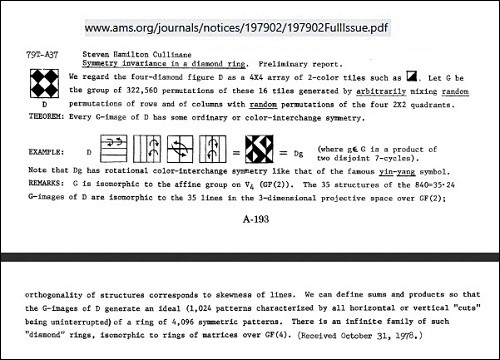
Yesterday's Wikipedia presentation of the square model was today
revised by yet another anonymous author —

Revision history accounting for the above change from yesterday —

The jargon "rm OR" means "remove original research."
The added verbiage about block designs is a smokescreen having
nothing to do with the subject, which is square representation
of the 35 points and lines.
* The 35 squares, each consisting of four 4-element subsets, appeared earlier
in the Miracle Octad Generator (MOG) of R. T. Curtis (published in 1976).
They were not at that time presented as constituting a finite geometry,
either affine (AG(4,2)) or projective (PG(3,2)).
Comments Off on Wikipedia Scholarship (Continued)
Sunday, January 13, 2019

For some context, see "A Riddle for Davos."

Comments Off on Sunday the Thirteenth (Revisited)
Tuesday, December 18, 2018
The title abbreviates* that of a collection of Wittgenstein's remarks:
|
Ludwig Wittgenstein — Culture and Value
Revised Edition, Wiley-Blackwell (1998)
Showing 20 results for spirit —
page 18, rubble & finally a heap of ashes; but spirits will hover over the ashes. MS 107 229:
page 18, Page 5 Only something supernatural can expre
page 20, contemplating it from above in its†c flight.†
page 21, spirit in which it is written.†f This spirit is, I believe, different from that of t
page 21, and American civilization. The spirit of this civilization the expression of
page 21, day†h fascism & socialism, is a spirit that is alien & uncongenial†i to the au
page 21, he Page Break 9 can work in the spirit of the whole, and his strength can with
page 21, straight for what is concrete. Which is chara
page 22, danger in a long foreword is that the spirit of a book has to be evident in the book
page 22, It is all one to me whether the typical weste
page 23, a great temptation to want to make the spirit explicit. MS 109 204: 6-7.11.1930 Page
page 23, readers that will be clear just from the fact
page 28, Foggy day. Grey autumn haunts us. Laughter se
page 42, If one wanted to characterize the essence of
page 51, attention from what matters.) The Spirit puts what is essential, essential for y
page 51, how far all this is exactly in the spirit of Kierkegaard.) MS 119 151: 22.10.1937
page 51, something feminine about this outlook?) MS 11
page 100, comfortable, clearer expression, but cannot b
page 106, act otherwise."–Perhaps, though, one might s
page 210, Page 7 †b function Page 7 †c from its Page
****************************************************************
|
The above "spirit guide" was suggested by yesterday's post
on Knuth as Yoda and by the paper in today's previous post,
"Shadowhunter Tales."
This post's title, "CV," is from . . .

Comments Off on CV
The recent post "Tales from Story Space," about the 18th birthday
of the protagonist in the TV series "Shadowhunters" (2016-),
suggests a review of the actual 18th birthday of actress Lily Collins.
Collins is shown below warding off evil with a magical rune as
a shadowhunter in the 2013 film "City of Bones" —

She turned 18 on March 18, 2007. A paper on symmetry and logic
referenced here on that date displays the following "runes" of
philosopher Charles Sanders Peirce —

See also Adamantine Meditation (Log24, Oct. 3, 2018)
and the webpage Geometry of the I Ching.
Comments Off on Shadowhunter Tales
Monday, August 27, 2018


From the former date above —
|
Saturday, September 17, 2016
|
From the latter date above —
|
Tuesday, October 18, 2016
The term "parametrization," as discussed in Wikipedia, seems useful for describing labelings that are not, at least at first glance, of a vector-space nature.
Examples: The labelings of a 4×4 array by a blank space plus the 15 two-subsets of a six-set (Hudson, 1905) or by a blank plus the 5 elements and the 10 two-subsets of a five-set (derived in 2014 from a 1906 page by Whitehead), or by a blank plus the 15 line diagrams of the diamond theorem.
Thus "parametrization" is apparently more general than the word "coodinatization" used by Hermann Weyl —
“This is the relativity problem: to fix objectively a class of equivalent coordinatizations and to ascertain the group of transformations S mediating between them.”
— Hermann Weyl, The Classical Groups , Princeton University Press, 1946, p. 16
Note, however, that Weyl's definition of "coordinatization" is not limited to vector-space coordinates. He describes it as simply a mapping to a set of reproducible symbols .
(But Weyl does imply that these symbols should, like vector-space coordinates, admit a group of transformations among themselves that can be used to describe transformations of the point-space being coordinatized.)
|
From March 2018 —

Comments Off on Children of the Six Sides
Friday, July 20, 2018
(Continued)
Click image to enlarge —


A portrait from the home page of David Eppstein,
a professor at the University of California, Irvine
“… how can an image with 8 points and 8 lines
possibly represent a space with 7 points and 7 lines???“
— David Eppstein, 21 December 2015
See ” Projective spaces as ‘collapsed vector spaces,’ ”
page 203 in Geometry and Symmetry by Paul B. Yale,
published by Holden-Day in 1968.
Comments Off on Geometry for Jews
Sunday, June 10, 2018
The previous post was suggested by some April 17, 2016, remarks
by James Propp on the eightfold cube.
Propp's remarks included the following:
"Here’s a caveat about my glib earlier remark that
'There are only finitely many numbers ' in a finite field.
It’s a bit of a stretch to call the elements of finite fields
'numbers'. Elements of GF(q ) can be thought of as
the integers mod q when q is prime, and they can be
represented by 0, 1, 2, …, q–1; but when q is a prime
raised to the 2nd power or higher, describing the
elements of GF(q ) is more complicated, and the word
'number' isn’t apt."
Related material —

See also this journal on the date of Propp's remarks — April 17, 2016.
Comments Off on Number Concept
Saturday, June 2, 2018


See as well Kipnis.
Comments Off on 6/2
Friday, May 4, 2018
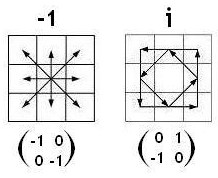
A star figure and the Galois quaternion.
The square root of the former is the latter.
See also a passage quoted here a year ago today
(May the Fourth, "Star Wars Day") —

Comments Off on Art & Design
Tuesday, April 24, 2018
Tom Wolfe in The Painted Word (1975) —
“I am willing (now that so much has been revealed!)
to predict that in the year 2000, when the Metropolitan
or the Museum of Modern Art puts on the great
retrospective exhibition of American Art 1945-75,
the three artists who will be featured, the three seminal
figures of the era, will be not Pollock, de Kooning, and
Johns-but Greenberg, Rosenberg, and Steinberg.
Up on the walls will be huge copy blocks, eight and a half
by eleven feet each, presenting the protean passages of
the period … a little ‘fuliginous flatness’ here … a little
‘action painting’ there … and some of that ‘all great art
is about art’ just beyond. Beside them will be small
reproductions of the work of leading illustrators of
the Word from that period….”

The above group of 322,560 permutations appears also in a 2011 book —

— and in 2013-2015 papers by Anne Taormina and Katrin Wendland:
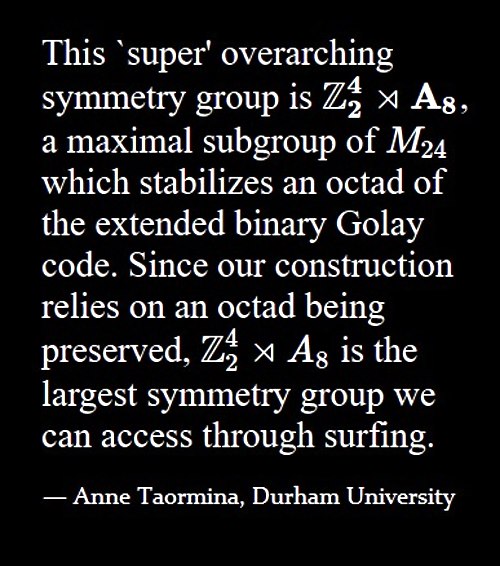
Comments Off on Illustrators of the Word
Monday, April 23, 2018
Saturday, April 7, 2018
The FBI holding cube in "The Blacklist" —

" 'The Front' is not the whole story . . . ."
— Vincent Canby, New York Times film review, 1976,
as quoted in Wikipedia.
See also Solomon's Cube in this journal.


Some may view the above web page as illustrating the
Glasperlenspiel passage quoted here in Summa Mythologica —
“"I suddenly realized that in the language, or at any rate
in the spirit of the Glass Bead Game, everything actually
was all-meaningful, that every symbol and combination of
symbols led not hither and yon, not to single examples,
experiments, and proofs, but into the center, the mystery
and innermost heart of the world, into primal knowledge.
Every transition from major to minor in a sonata, every
transformation of a myth or a religious cult, every classical
or artistic formulation was, I realized in that flashing moment,
if seen with a truly meditative mind, nothing but a direct route
into the interior of the cosmic mystery, where in the alternation
between inhaling and exhaling, between heaven and earth,
between Yin and Yang, holiness is forever being created.”
A less poetic meditation on the above 4x4x4 design cube —
"I saw that in the alternation between front and back,
between top and bottom, between left and right,
symmetry is forever being created."
See also a related remark by Lévi-Strauss in 1955:
"…three different readings become possible:
left to right, top to bottom, front to back."
Comments Off on Sides
Wednesday, April 4, 2018

See as well a search for "Gold Bug" in this journal.
From that search —
Richard Powers, The Gold Bug Variations , first published in 1991—
Botkin, whatever her gifts as a conversationist, is almost as old
as the rediscovery of Mendel. The other extreme in age,
Joe Lovering, beat a time-honored path out of pure math
into muddy population statistics. Ressler has seen the guy
potting about in the lab, although exactly what the excitable kid
does is anybody's guess. He looks decidedly gumfooted holding
any equipment more corporeal than a chi-square. Stuart takes
him to the Y for lunch, part of a court-your-resources campaign.
He has the sub, Lovering the congealed mac and cheese.
Hardly are they seated when Joe whips out a napkin and begins
sketching proofs. He argues that the genetic code, as an
algorithmic formal system, is subject to Gödel's Incompleteness
Theorem. "That would mean the symbolic language of the code
can't be both consistent and complete. Wouldn't that be a kick
in the head?"
Kid talk, competitive showing off, intellectual fantasy.
But Ressler knows what Joe is driving at. He's toyed with similar
ideas, cast in less abstruse terms. We are the by-product of the
mechanism in there. So it must be more ingenious than us.
Anything complex enough to create consciousness may be too
complex for consciousness to understand. Yet the ultimate paradox
is Lovering, crouched over his table napkin, using proofs to
demonstrate proof's limits. Lovering laughs off recursion and takes
up another tack: the key is to find some formal symmetry folded
in this four-base chaos. Stuart distrusts this approach even more.
He picks up the tab for their two untouched lunches, thanking
Lovering politely for the insight.
"The key is to find some formal symmetry…."

Comments Off on Gold Bug Variations (Continued)
Tuesday, April 3, 2018
"On Tralfamadore, Billy is put in a transparent geodesic dome
exhibit in a zoo; the dome represents a house on Earth.
The Tralfamadorians later abduct a movie star named
Montana Wildhack, who had disappeared and was believed to
have drowned herself in the Pacific Ocean. They intend to
have her mate with Billy." — Wikipedia on Kurt Vonnegut's
Slaughterhouse-Five .
See also the previous post and (from Log24 on Jan. 22) "Hollywood Moment" …

Comments Off on Montana Wildhack
Tuesday, March 27, 2018

Related material on automorphism groups —

The "Eightfold Cube" structure shown above with Weyl
competes rather directly with the "Eightfold Way" sculpture
shown above with Bryant. The structure and the sculpture
each illustrate Klein's order-168 simple group.
Perhaps in part because of this competition, fans of the Mathematical
Sciences Research Institute (MSRI, pronounced "Misery') are less likely
to enjoy, and discuss, the eight-cube mathematical structure above
than they are an eight-cube mechanical puzzle like the one below.

Note also the earlier (2006) "Design Cube 2x2x2" webpage
illustrating graphic designs on the eightfold cube. This is visually,
if not mathematically, related to the (2010) "Expert's Cube."
Comments Off on Compare and Contrast
Wednesday, March 7, 2018

Related material —
The seven points of the Fano plane within
The Eightfold Cube.
"Before time began . . . ."
— Optimus Prime
Comments Off on Unite the Seven.
Saturday, February 17, 2018
Michael Atiyah on the late Ron Shaw —

Phrases by Atiyah related to the importance in mathematics
of the two-element Galois field GF(2) —
- “The digital revolution based on the 2 symbols (0,1)”
- “The algebra of George Boole”
- “Binary codes”
- “Dirac’s spinors, with their up/down dichotomy”
These phrases are from the year-end review of Trinity College,
Cambridge, Trinity Annual Record 2017 .
I prefer other, purely geometric, reasons for the importance of GF(2) —
- The 2×2 square
- The 2x2x2 cube
- The 4×4 square
- The 4x4x4 cube
See Finite Geometry of the Square and Cube.
See also today’s earlier post God’s Dice and Atiyah on the theology of
(Boolean) algebra vs. (Galois) geometry:

Comments Off on The Binary Revolution
On a Trinity classmate of Ian Macdonald (see previous post)—

Atiyah's eulogy of Shaw in Trinity Annual Record 2017
is on pages 137 through 146. The conclusion —

Comments Off on God’s Dice
Monday, January 22, 2018



A death on the date of the above symmetry chat,
Wednesday, August 17, 2016 —

An Hispanic Hollywood moment:
Ojo de Dios —

Click for related material.
For further Hispanic entertainment,
see Ben Affleck sing
"Aquellos Ojos Verdes "
in "Hollywoodland."
Comments Off on Hollywood Moment
Friday, January 5, 2018
From "The Principle of Sufficient Reason," by George David Birkhoff,
in "Three Public Lectures on Scientific Subjects,"
delivered at the Rice Institute, March 6, 7, and 8, 1940 —

From the same lecture —
|
Up to the present point my aim has been to consider a variety of applications of the Principle of Sufficient Reason, without attempting any precise formulation of the Principle itself. With these applications in mind I will venture to formulate the Principle and a related Heuristic Conjecture in quasi-mathematical form as follows:
PRINCIPLE OF SUFFICIENT REASON. If there appears in any theory T a set of ambiguously determined ( i e . symmetrically entering) variables, then these variables can themselves be determined only to the extent allowed by the corresponding group G. Consequently any problem concerning these variables which has a uniquely determined solution, must itself be formulated so as to be unchanged by the operations of the group G ( i e . must involve the variables symmetrically).
HEURISTIC CONJECTURE. The final form of any scientific theory T is: (1) based on a few simple postulates; and (2) contains an extensive ambiguity, associated symmetry, and underlying group G, in such wise that, if the language and laws of the theory of groups be taken for granted, the whole theory T appears as nearly self-evident in virtue of the above Principle.
The Principle of Sufficient Reason and the Heuristic Conjecture, as just formulated, have the advantage of not involving excessively subjective ideas, while at the same time retaining the essential kernel of the matter.
In my opinion it is essentially this principle and this conjecture which are destined always to operate as the basic criteria for the scientist in extending our knowledge and understanding of the world.
It is also my belief that, in so far as there is anything definite in the realm of Metaphysics, it will consist in further applications of the same general type. This general conclusion may be given the following suggestive symbolic form:

While the skillful metaphysical use of the Principle must always be regarded as of dubious logical status, nevertheless I believe it will remain the most important weapon of the philosopher.
|
Related remarks by a founding member of the Metaphysical Club:

See also the previous post, "Seven Types of Interality."
Comments Off on Types of Ambiguity
Wednesday, December 27, 2017
"There is always an awareness in her fiction
of the subjectivity of perception, and
the kaleidoscopic permutations
that memory can work on reality."
This is from a New York Times article subtitled
"Alice Munro, Nobel Winner, Mines the Inner Lives
of Girls and Women" …
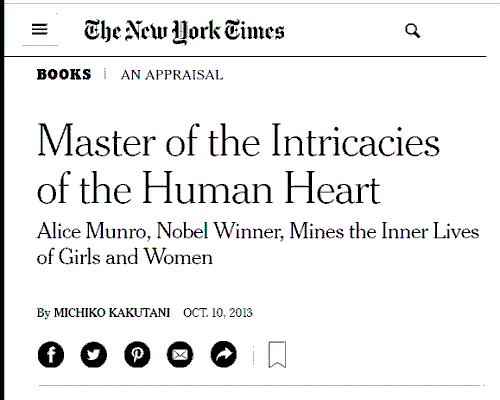
The New York Times article was linked to by Marjorie Senechal
in a Huffington Post article of All Saints' Day 2013.
Further material on kaleidoscopic permutations —
See the Log24 post Symmetry of May 3, 2016.
For further material on mining, see Diamond-Mine:

"SEE HEAR READ" — Walt Disney Productions
Comments Off on On Fiction and Mathematics
Tuesday, December 26, 2017
(Continued)
Two Students of Structure
A comment on Sean Kelly's Christmas Morning column on "aliveness"
in the New York Times philosophy series The Stone —

Diana Senechal's 1999 doctoral thesis at Yale was titled
"Diabolical Structures in the Poetics of Nikolai Gogol."
Her mother, Marjorie Senechal, has written extensively on symmetry
and served as editor-in-chief of The Mathematical Intelligencer .
From a 2013 memoir by Marjorie Senechal —
|
"While I was in Holland my enterprising student assistant at Smith had found, in Soviet Physics – Crystallography, an article by N. N. Sheftal' on tetrahedral penetration twins. She gave it to me on my return. It was just what I was looking for. The twins Sheftal' described had evidently begun as (111) contact twins, with the two crystallites rotated 60o with respect to one another. As they grew, he suggested, each crystal overgrew the edges of the other and proceeded to spread across the adjacent facet. When all was said and done, they looked like they'd grown through each other, but the reality was over-and-around. Brilliant! I thought. Could I apply this to cubes? No, evidently not. Cube facets are all (100) planes. But . . . these crystals might not have been cubes in their earliest stages, when twinning occurred! I wrote a paper on "The mechanism of certain growth twins of the penetration type" and sent it to Martin Buerger, editor of Neues Jarbuch für Mineralogie. This was before the Wrinch symposium; I had never met him. Buerger rejected it by return mail, mostly on the grounds that I hadn't quoted any of Buerger's many papers on twinning. And so I learned about turf wars in twin domains. In fact I hadn't read his papers but I quickly did. I added a reference to one of them, the paper was published, and we became friends.[5]
After reading Professor Sheftal's paper I wrote to him in Moscow; a warm and encouraging correspondence ensued, and we wrote a paper together long distance.[6] Then I heard about the scientific exchanges between the Academies of Science of the USSR and USA. I applied to spend a year at the Shubnikov Institute for Crystallography, where Sheftal' worked. I would, I proposed, study crystal growth with him, and color symmetry with Koptsik. To my delight, I was accepted for an 11-month stay. Of course the children, now 11 and 14, would come too and attend Russian schools and learn Russian; they'd managed in Holland, hadn't they? Diana, my older daughter, was as delighted as I was. We had gone to Holland on a Russian boat, and she had fallen in love with the language. (Today she holds a Ph.D. in Slavic Languages and Literature from Yale.) . . . .
. . . we spent the academic year 1978-79 in Moscow.
|
Philosophy professors and those whose only interest in mathematics
is as a path to the occult may consult the Log24 posts tagged Tsimtsum.
Comments Off on Raiders of the Lost Stone
Thursday, December 21, 2017
A review —

Some context —

Comments Off on For Winter Solstice 2017
Wednesday, November 22, 2017
David E. Wellbery on Goethe
From an interview published on 2 November 2017 at
http://literaturwissenschaft-berlin.de/interview-with-david-wellbery/
as later republished in
https://thepointmag.com/2017/dialogue/
irreducible-significance-david-wellbery-literature-goethe-cavell —

The logo at left above is that of The Point .
The menu icon at right above is perhaps better
suited to illustrate Verwandlungslehre .

Comments Off on Goethe on All Souls’ Day
Saturday, November 18, 2017
Comments Off on Cube Space Continued
Tuesday, October 31, 2017
See the previous post and College of the Desert in this journal.
From the latter, see particularly Slide 69 in Geoff Hagopian's Symmetry.
Comments Off on For All Hallows’ Eve
Saturday, October 28, 2017
A sequel to the post CP is for Consolation Prize (Sept. 3, 2016)
An image from Log24 on this date last year:

A recent comment on a discussion of CP symmetry —

Comments Off on Lowell Brown at Vanity Fair
Thursday, October 19, 2017
The elementary shapes at the top of the figure below mirror
the looking-glass property of the classical Lo Shu square.
The nine shapes at top left* and their looking-glass reflection
illustrate the looking-glass reflection relating two orthogonal
Latin squares over the three digits of modulo-three arithmetic.
Combining these two orthogonal Latin squares,** we have a
representation in base three of the numbers from 0 to 8.
Adding 1 to each of these numbers yields the Lo Shu square.

* The array at top left is from the cover of
Wonder Years:
Werkplaats Typografie 1998-2008.
** A well-known construction.
*** For other instances of what might be
called "design grammar" in combinatorics,
see a slide presentation by Robin Wilson.
No reference to the work of Chomsky is
intended.
Comments Off on Design Grammar***
Wednesday, October 4, 2017
Text —
"A field is perhaps the simplest algebraic structure we can invent."
— Hermann Weyl, 1952
Context —

See also yesterday's Personalized Book Search.
|
Full text of Symmetry – Internet Archive —
https://archive.org/details/Symmetry_482
A field is perhaps the simplest algebraic 143 structure
we can invent. Its elements are numbers. Characteristic
for its structure are the operations of addition and …
|
From a Log24 search for Mathematics+Nutshell —
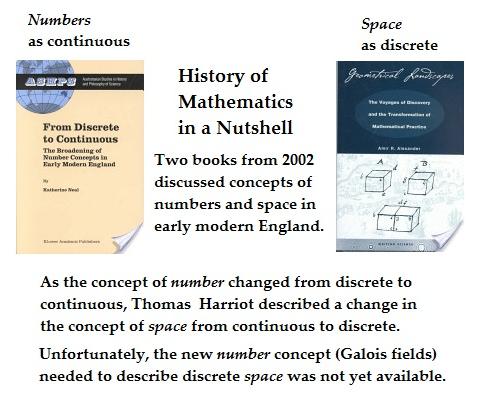
Comments Off on Text and Context
Tuesday, September 12, 2017
The New York Times online this evening —
"Mr. Jobs, who died in 2011, loomed over Tuesday’s
nostalgic presentation. The Apple C.E.O., Tim Cook,
paid tribute, his voice cracking with emotion, Mr. Jobs’s
steeple-fingered image looming as big onstage as
Big Brother’s face in the classic Macintosh '1984' commercial."
— James Poniewozik
Review —
|
Thursday, September 1, 2011
Filed under: Uncategorized — Tags: Geometry, Priority — m759 @ 11:00 AM
"Design is how it works." — Steven Jobs (See Symmetry and Design.)
"By far the most important structure in design theory is the Steiner system S(5, 8, 24)."
— "Block Designs," by Andries E. Brouwer
. . . .
|
See also 1984 Bricks in this journal.
Comments Off on Think Different
Saturday, September 9, 2017
Del Toro and the History of Mathematics ,
Or: Applied Bullshit Continues
For del Toro —


For the history of mathematics —
|
Thursday, September 1, 2011
Filed under: Uncategorized — Tags: Geometry, Priority — m759 @ 11:00 AM
"Design is how it works." — Steven Jobs (See Symmetry and Design.)
"By far the most important structure in design theory is the Steiner system S(5, 8, 24)."
— "Block Designs," by Andries E. Brouwer
. . . .
|
Comments Off on How It Works
Thursday, August 31, 2017
In a book to be published Sept. 5 by Princeton University Press,
John Conway, Simon Norton, and Alex Ryba present the following
result on order-four magic squares —

A monograph published in 1976, “Diamond Theory,” deals with
more general 4×4 squares containing entries from the Galois fields
GF(2), GF(4), or GF(16). These squares have remarkable, if not
“magic,” symmetry properties. See excerpts in a 1977 article.
See also Magic Square and Diamond Theorem in this journal.
Comments Off on A Conway-Norton-Ryba Theorem
Saturday, August 19, 2017
From a trailer for the 2013 Dutch film "App" —


From the online New York Times yesterday —

See also Overarching + Symmetry in this journal.

Comments Off on App
Friday, July 28, 2017
In memory of a Disney "imagineer" who reportedly died yesterday.
From the opening scene of a 2017 film, "Gifted":
Frank calls his niece Mary to breakfast on the morning she is
to enter first grade. She is dressed, for the first time, for school —
- Hey! Come on. Let's move!
- No!
- Let me see.
- No.
- Come on, I made you special breakfast.
- You can't cook.
- Hey, Mary, open up.
(She opens her door and walks out.)
- You look beautiful.
- I look like a Disney character.
Where's the special?
- What?
- You said you made me special breakfast.
Read more: http://www.springfieldspringfield.co.uk/
movie_script.php?movie=gifted
|


Comments Off on Aesthetic Distance
Wednesday, June 21, 2017
Remark on conceptual art quoted in the previous post —
"…he’s giving the concept but not the realization."
A concept — See a note from this date in 1983:

A realization —

Not the best possible realization, but enough for proof of concept .
Comments Off on Concept and Realization
Tuesday, June 20, 2017
(Continued)
"For years, the AllSpark rested, sitting dormant
like a giant, useless art installation."
— Vinnie Mancuso at Collider.com yesterday
Related material —
Dormant cube —

Giant, useless art installation —
Sol LeWitt at MASS MoCA. See also LeWitt in this journal.
Comments Off on All-Spark Notes
Sunday, May 28, 2017
In memory of John Severson, the founder of Surfer magazine —
"Freeze-frame surfer, and as a live Hendrix 'E Z Rider' blares
over the soundtrack, the surfer lifts his arms and rises like Christ
into the sky."
— Rolling Stone , August 5, 1971, on the film Rainbow Bridge
Severson reportedly died on Friday, May 26, 2017.
For a rather different sort of surfing, see this journal on that date.
Comments Off on Freeze Frame
Friday, May 26, 2017

Mark Zuckerberg in a commencement speech
at Harvard yesterday —
"Movies and pop culture get this all wrong.
The idea of a single eureka moment
is a dangerous lie. It makes us feel inadequate
since we haven’t had ours. It prevents people
with seeds of good ideas from getting started.
Oh, you know what else movies get wrong about
innovation? No one writes math formulas on glass.
That’s not a thing."
The Thing from Taormina —

Comments Off on Taormina Test
Thursday, May 11, 2017


See also Chandrasekharan in a Log24 search for Weyl+Schema.
Update of 6:16 AM Friday, May 12, 2017 —


The phrase "smallest perfect universe" is from Burkard Polster (2001).
Comments Off on In Memoriam
Thursday, May 4, 2017

From a post on April 1, the reported date of his death —

Comments Off on In Memory of Burton Watson
Friday, April 21, 2017
For the music box of the title, see the previous post.

See also Mazzola on the Glass Bead Game
(Facebook date June 7, 2016)
and the Log24 post Symmetry (May 3, 2016).
Comments Off on Music Box — The Theory
Monday, April 3, 2017
Saturday, April 1, 2017

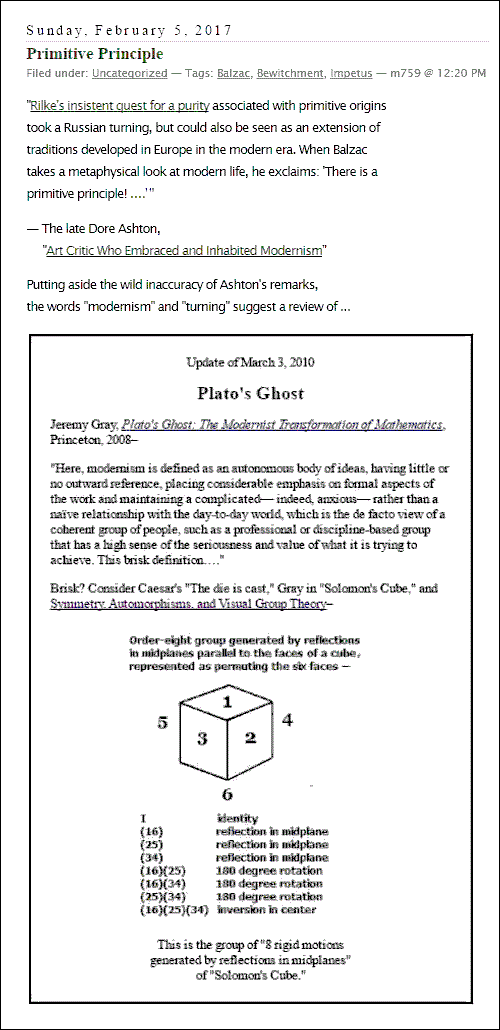
Prequel —

Note that Yale's die design and use of the phrase "rigid motions"
differ from those in the webpage "Solomon's Cube."
Comments Off on Beyond All Recognition
Sunday, March 26, 2017

From a search in this journal for Seagram + Tradition —

Related art: Saturday afternoon's Twin Pillars of Symmetry.
Comments Off on Seagram Studies
Thursday, March 9, 2017
Comments Off on Gr-r-reat Again
Friday, February 24, 2017
An arXiv article from Good Friday, 2003, by Igor Dolgachev,
a student of the late Igor Shafarevich (see previous post) —

See also my Dec. 29, 1986, query on Duality and Symmetry.
Comments Off on Abstract Configurations on Good Friday
Friday, February 17, 2017
"Bertram Kostant, professor emeritus of mathematics at MIT,
died at the Hebrew Senior Rehabilitation Center in Roslindale,
Massachusetts, on Thursday, Feb. 2, at the age of 88."
— MIT News, story dated Feb. 16, 2017
See also a search for Kostant in this journal.
Regarding the discussions of symmetries and "facets" found in
that search —
Kostant:
“A word about E(8). In my opinion, and shared by others,
E(8) is the most magnificent ‘object’ in all of mathematics.
It is like a diamond with thousands of facets. Each facet
offering a different view of its unbelievable intricate internal
structure.”
Cullinane:
In the Steiner system S(5, 8, 24) each octad might be
regarded as a "facet," with the order of the system's
automorphism group, the Mathieu group M24 , obtained
by multiplying the number of such facets, 759, by the
order of the octad stabilizer group, 322,560.
Analogously …

Comments Off on Kostant Is Dead
Friday, December 23, 2016
From a Dec. 21 obituary posted by the
University of Tennessee at Knoxville —
"Wade was ordained as a pastor and served
at Oakwood Baptist Church in Knoxville."
Other information —

In a Log24 post, "Seeing the Finite Structure,"
of August 16, 2008, Wade appeared as a co-author
of the Walsh series book mentioned above —

Walsh Series: An Introduction
to Dyadic Harmonic Analysis,
by F. Schipp et al.,
Taylor & Francis, 1990
From the 2008 post —
The patterns on the faces of the cube on the cover
of Walsh Series above illustrate both the
Walsh functions of order 3 and the same structure
in a different guise, subspaces of the affine 3-space
over the binary field. For a note on the relationship
of Walsh functions to finite geometry, see
Symmetry of Walsh Functions.
Comments Off on Requiem for a Mathematician
Saturday, December 10, 2016
Images from Burkard Polster's Geometrical Picture Book —

See as well in this journal the large Desargues configuration, with
15 points and 20 lines instead of 10 points and 10 lines as above.
Exercise: Can the large Desargues configuration be formed
by adding 5 points and 10 lines to the above Polster model
of the small configuration in such a way as to preserve
the small-configuration model's striking symmetry?
(Note: The related figure below from May 21, 2014, is not
necessarily very helpful. Try the Wolfram Demonstrations
model, which requires a free player download.)
Labeling the Tetrahedral Model (Click to enlarge) —

Related folk etymology (see point a above) —

Related literature —
The concept of "fire in the center" at The New Yorker ,
issue dated December 12, 2016, on pages 38-39 in the
poem by Marsha de la O titled "A Natural History of Light."
Cézanne's Greetings.
Comments Off on Folk Etymology
Friday, November 25, 2016
Before the monograph "Diamond Theory" was distributed in 1976,
two (at least) notable figures were published that illustrate
symmetry properties of the 4×4 square:
Hudson in 1905 —

Golomb in 1967 —

It is also likely that some figures illustrating Walsh functions as
two-color square arrays were published prior to 1976.
Update of Dec. 7, 2016 —
The earlier 1950's diagrams of Veitch and Karnaugh used the
1's and 0's of Boole, not those of Galois.
Comments Off on Priority
Thursday, October 6, 2016
According to Octavio Paz and Claude Lévi-Strauss
"Poetry…. conceives of the text as a series of transparent strata
within which the various parts—the different verbal and semantic
currents— produce momentary configurations as they intertwine
or break apart, as they reflect each other or efface each other.
Poetry contemplates itself, fuses with itself, and obliterates itself
in the crystallizations of language. Apparitions, metamorphoses,
volatilizations, precipitations of presences. These configurations
are crystallized time…."
— Octavio Paz in The Monkey Grammarian (written in 1970)
"Strata" also seem to underlie the Lévi-Strauss "canonic formula" of myth
in its original 1955 context, described as that of permutation groups —

I do not recommend trying to make sense of the above "formula."
Related material —

"And six sides to bounce it all off of."
Comments Off on Key to All Mythologies…
Saturday, September 24, 2016
From Hermann Weyl's 1952 classic Symmetry —
"Galois' ideas, which for several decades remained
a book with seven seals but later exerted a more
and more profound influence upon the whole
development of mathematics, are contained in
a farewell letter written to a friend on the eve of
his death, which he met in a silly duel at the age of
twenty-one. This letter, if judged by the novelty and
profundity of ideas it contains, is perhaps the most
substantial piece of writing in the whole literature
of mankind."
Some Galois geometry —

See the previous post for more narrative.
Comments Off on The Seven Seals
Tuesday, September 20, 2016
As the Key to All Mythologies
For the theorem of the title, see "Diamond Theorem" in this journal.
"These were heavy impressions to struggle against,
and brought that melancholy embitterment which
is the consequence of all excessive claim: even his
religious faith wavered with his wavering trust in his
own authorship, and the consolations of the Christian
hope in immortality seemed to lean on the immortality
of the still unwritten Key to all Mythologies."
— Middlemarch , by George Eliot, Ch. XXIX
Related material from Sunday's print New York Times —

Sunday's Log24 sermon —

See also the Lévi-Strauss "Key to all Mythologies" in this journal,
as well as the previous post.
Comments Off on The Diamond Theorem …
Sunday, September 18, 2016
Saturday, September 17, 2016
Comments Off on Interior/Exterior
Comments Off on A Box of Nothing
Monday, September 12, 2016
The previous post quoted Tom Wolfe on Chomsky's use of
the word "array."
An example of particular interest is the 4×4 array
(whether of dots or of unit squares) —
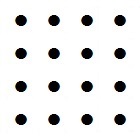
 .
.
Some context for the 4×4 array —
The following definition indicates that the 4×4 array, when
suitably coordinatized, underlies the Kummer lattice .

Further background on the Kummer lattice:
Alice Garbagnati and Alessandra Sarti,
"Kummer Surfaces and K3 surfaces
with $(Z/2Z)^4$ symplectic action."
To appear in Rocky Mountain J. Math. —

The above article is written from the viewpoint of traditional
algebraic geometry. For a less traditional view of the underlying
affine 4-space from finite geometry, see the website
Finite Geometry of the Square and Cube.
Some further context …
"To our knowledge, the relation of the Golay code
to the Kummer lattice … is a new observation."
— Anne Taormina and Katrin Wendland,
"The overarching finite symmetry group of
Kummer surfaces in the Mathieu group M24 "

As noted earlier, Taormina and Wendland seem not to be aware of
R. W. H. T. Hudson's use of the (uncoordinatized*) 4×4 array in his
1905 book Kummer's Quartic Surface. The array was coordinatized,
i.e. given a "vector space structure," by Cullinane eight years prior to
the cited remarks of Curtis.
* Update of Sept. 14: "Uncoordinatized," but parametrized by 0 and
the 15 two-subsets of a six-set. See the post of Sept. 13.
Comments Off on The Kummer Lattice
Monday, September 5, 2016
The Lévi-Strauss “canonic formula” of myth in its original 1955 context,
described as that of permutation groups —

Related material in this journal —
Dueling Formulas and Symmetry.
Comments Off on Structural Study
Saturday, September 3, 2016
CERN COURIER May 28, 1999:
In hot pursuit of CP violation
"CP was a consolation prize for physicists.
At least it seemed so until 1964."
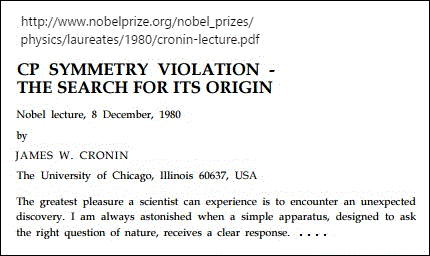

"James W. Cronin, who shared the Nobel Prize in physics
for discovering a startling breakdown in what was assumed
to be the immutable symmetry of physical law, thereby
helping to explain the behavior and evolution of the universe
as a whole, died Aug. 25 in St. Paul, Minn. He was 84.
Dr. Cronin’s death was announced by the University of Chicago,
where he was a professor emeritus of physics as well as of
astronomy and astrophysics. No cause was reported."
— Martin Weil in The Washington Post , August 28, 2016
Comments Off on CP is for Consolation Prize
Filed under: — m759 @ 2:01 pm
CERN COURIER May 28, 1999:
In hot pursuit of CP violation
"CP was a consolation prize for physicists.
At least it seemed so until 1964."


"James W. Cronin, who shared the Nobel Prize in physics
for discovering a startling breakdown in what was assumed
to be the immutable symmetry of physical law, thereby
helping to explain the behavior and evolution of the universe
as a whole, died Aug. 25 in St. Paul, Minn. He was 84.
Dr. Cronin’s death was announced by the University of Chicago,
where he was a professor emeritus of physics as well as of
astronomy and astrophysics. No cause was reported."
— Martin Weil in The Washington Post , August 28, 2016
Comments Off on CP is for Consolation Prize
Friday, August 19, 2016
Comments Off on Ex Machina
Friday, August 5, 2016
From an earlier Log24 post —
From a post of the next day, July 12, 2014 —

"So there are several different genres and tones
jostling for prominence within Lexicon :
a conspiracy thriller, an almost abstract debate
about what language can do, and an ironic
questioning of some of the things it’s currently used for."
— Graham Sleight in The Washington Post
a year earlier, on July 15, 2013
For the Church of Synchronology, from Log24 on the next day —

From a post titled Circles on the date of Marc Simont's death —

See as well Verhexung in this journal.
Comments Off on Sleight of Post
Thursday, July 21, 2016

See also, from that same day, "24-Part Invention."
* The title is a reference to a 2001 article by Cartier on
"the evolution of concepts of space and symmetry" —

Comments Off on A Mad Day’s Preprint*
Saturday, June 4, 2016
"The editors are also grateful to
T. Kibble and Imperial College Press
for permission to reprint B. Zumino's paper
'Supersymmetry: A Personal View' . . . ."
— Preface to Symmetry in Mathematics and Physics
(AMS, 2009), a book based on talks at
a UCLA conference of Jan. 18-20, 2008
(For the book's title page, see yesterday morning's post Symmetry.)
This suggests a search in this journal for the term "supersymmetry."
That search yields some links that may be of further interest to
devotees of the Church of Synchronology.
Comments Off on A Personal View
Sunday, May 29, 2016
According to McLuhan
Marshall McLuhan writing to Ezra Pound on Dec. 21, 1948—
"The American mind is not even close to being amenable
to the ideogram principle as yet. The reason is simply this.
America is 100% 18th Century. The 18th century had
chucked out the principle of metaphor and analogy—
the basic fact that as A is to B so is C to D. AB:CD.
It can see AB relations. But relations in four terms are still
verboten. This amounts to deep occultation of nearly all
human thought for the U.S.A.
I am trying to devise a way of stating this difficulty as it exists.
Until stated and publicly recognized for what it is, poetry and
the arts can’t exist in America."
For context, see Cameron McEwen,
"Marshall McLuhan, John Pick, and Gerard Manley Hopkins."
(Renascence , Fall 2011, Vol. 64 Issue 1, 55-76)
A relation in four terms —
A : B :: C : D as Model : Crutch :: Metaphor : Ornament —

See also Dueling Formulas and Symmetry.
Comments Off on The Ideogram Principle …
Wednesday, May 25, 2016
"Studies of spin-½ theories in the framework of projective geometry
have been undertaken before." — Y. Jack Ng and H. van Dam,
February 20, 2009
For one such framework,* see posts from that same date
four years earlier — February 20, 2005.
* A 4×4 array. See the 1977, 1978, and 1986 versions by
Steven H. Cullinane, the 1987 version by R. T. Curtis, and
the 1988 Conway-Sloane version illustrated below —
Cullinane, 1977

Cullinane, 1978

Cullinane, 1986

Curtis, 1987

Update of 10:42 PM ET on Sunday, June 19, 2016 —
The above images are precursors to …
Conway and Sloane, 1988

Update of 10 AM ET Sept. 16, 2016 — The excerpt from the
1977 "Diamond Theory" article was added above.
Comments Off on Framework
Sunday, May 22, 2016

A less metaphysical approach to a "pre-form" —
From Wallace Stevens, "The Man with the Blue Guitar":
IX
And the color, the overcast blue
Of the air, in which the blue guitar
Is a form, described but difficult,
And I am merely a shadow hunched
Above the arrowy, still strings,
The maker of a thing yet to be made . . . .

"Arrowy, still strings" from the diamond theorem
See also "preforming" and the blue guitar
in a post of May 19, 2010.
Update of 7:11 PM ET:
More generally, see posts tagged May 19 Gestalt.
Comments Off on Sunday School
Friday, May 6, 2016
Wednesday, May 4, 2016

Material related to the previous post, "Symmetry" —

This is the group of "8 rigid motions
generated by reflections in midplanes"
of "Solomon's Cube."
Material from this journal on May 1, the date of Golomb's death —
"Weitere Informationen zu diesem Themenkreis
finden sich unter http://www.encyclopediaofmath.org/
index.php/Cullinane_diamond_theorem und
http://finitegeometry.org/sc/gen/coord.html ."
Comments Off on Solomon Golomb, 1932-2016
Wednesday, April 27, 2016
Three notes on local symmetries
that induce global symmetries
From July 1, 2011 —
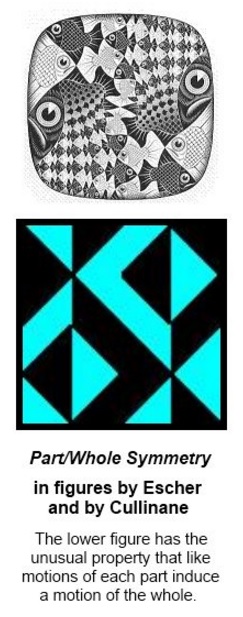
From November 5, 1981 —

From December 24, 1981 —
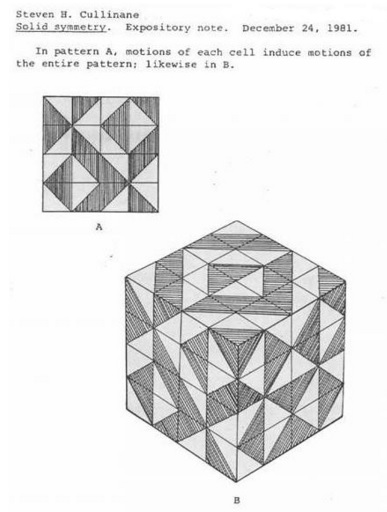
Comments Off on Local and Global
Tuesday, April 26, 2016
Peter Schjeldahl on Wallace Stevens in the current New Yorker —
"Stevens was born in 1879 in Reading, Pennsylvania,
the second of five children. His father, from humble
beginnings, was a successful lawyer, his mother a
former schoolteacher. Each night, she read a chapter
of the Bible to the children, who attended schools
attached to both Presbyterian and Lutheran churches,
where the music left an indelible impression on Stevens.
Both sides of the family were Pennsylvania Dutch,
an identity that meant little to him when he was young
but a great deal later on, perhaps to shore up a precarious
sense of identity."
See also this journal on Christmas Day, 2010 —

It's a start. For more advanced remarks from the same date, see Mere Geometry.
Comments Off on A Sense of Identity
Monday, April 25, 2016
An old version of the Wikipedia article "Group theory"
(pictured in the previous post) —

"More poetically …"
From Hermann Weyl's 1952 classic Symmetry —
"Galois' ideas, which for several decades remained
a book with seven seals but later exerted a more
and more profound influence upon the whole
development of mathematics, are contained in
a farewell letter written to a friend on the eve of
his death, which he met in a silly duel at the age of
twenty-one. This letter, if judged by the novelty and
profundity of ideas it contains, is perhaps the most
substantial piece of writing in the whole literature
of mankind."
The seven seals from the previous post, with some context —

These models of projective points are drawn from the underlying
structure described (in the 4×4 case) as part of the proof of the
Cullinane diamond theorem .
Comments Off on Seven Seals

Compare and contrast Peirce's seven systems of metaphysics with
the seven projective points in a post of March 1, 2010 —

From my commentary on Carter's question —

Comments Off on Peirce’s Accounts of the Universe
Sunday, April 17, 2016
The New York Times philosophy column yesterday —

The Times's philosophy column "The Stone" is named after the legendary
"philosophers' stone." The column's name, and the title of its essay yesterday
"Is that even a thing?" suggest a review of the eightfold cube as "The object
most closely resembling a 'philosophers' stone' that I know of" (Page 51 of
the current issue of a Norwegian art quarterly, KUNSTforum.as).
The eightfold cube —

|
Definition of Epiphany
From James Joyce’s Stephen Hero , first published posthumously in 1944. The excerpt below is from a version edited by John J. Slocum and Herbert Cahoon (New York: New Directions Press, 1959).
Three Times:
… By an epiphany he meant a sudden spiritual manifestation, whether in the vulgarity of speech or of gesture or in a memorable phase of the mind itself. He believed that it was for the man of letters to record these epiphanies with extreme care, seeing that they themselves are the most delicate and evanescent of moments. He told Cranly that the clock of the Ballast Office was capable of an epiphany. Cranly questioned the inscrutable dial of the Ballast Office with his no less inscrutable countenance:
— Yes, said Stephen. I will pass it time after time, allude to it, refer to it, catch a glimpse of it. It is only an item in the catalogue of Dublin’s street furniture. Then all at once I see it and I know at once what it is: epiphany.
— What?
— Imagine my glimpses at that clock as the gropings of a spiritual eye which seeks to adjust its vision to an exact focus. The moment the focus is reached the object is epiphanised. It is just in this epiphany that I find the third, the supreme quality of beauty.
— Yes? said Cranly absently.
— No esthetic theory, pursued Stephen relentlessly, is of any value which investigates with the aid of the lantern of tradition. What we symbolise in black the Chinaman may symbolise in yellow: each has his own tradition. Greek beauty laughs at Coptic beauty and the American Indian derides them both. It is almost impossible to reconcile all tradition whereas it is by no means impossible to find the justification of every form of beauty which has ever been adored on the earth by an examination into the mechanism of esthetic apprehension whether it be dressed in red, white, yellow or black. We have no reason for thinking that the Chinaman has a different system of digestion from that which we have though our diets are quite dissimilar. The apprehensive faculty must be scrutinised in action.
— Yes …
— You know what Aquinas says: The three things requisite for beauty are, integrity, a wholeness, symmetry and radiance. Some day I will expand that sentence into a treatise. Consider the performance of your own mind when confronted with any object, hypothetically beautiful. Your mind to apprehend that object divides the entire universe into two parts, the object, and the void which is not the object. To apprehend it you must lift it away from everything else: and then you perceive that it is one integral thing, that is a thing. You recognise its integrity. Isn’t that so?
— And then?
— That is the first quality of beauty: it is declared in a simple sudden synthesis of the faculty which apprehends. What then? Analysis then. The mind considers the object in whole and in part, in relation to itself and to other objects, examines the balance of its parts, contemplates the form of the object, traverses every cranny of the structure. So the mind receives the impression of the symmetry of the object. The mind recognises that the object is in the strict sense of the word, a thing , a definitely constituted entity. You see?
— Let us turn back, said Cranly.
They had reached the corner of Grafton St and as the footpath was overcrowded they turned back northwards. Cranly had an inclination to watch the antics of a drunkard who had been ejected from a bar in Suffolk St but Stephen took his arm summarily and led him away.
— Now for the third quality. For a long time I couldn’t make out what Aquinas meant. He uses a figurative word (a very unusual thing for him) but I have solved it. Claritas is quidditas . After the analysis which discovers the second quality the mind makes the only logically possible synthesis and discovers the third quality. This is the moment which I call epiphany. First we recognise that the object is one integral thing, then we recognise that it is an organised composite structure, a thing in fact: finally, when the relation of the parts is exquisite, when the parts are adjusted to the special point, we recognise that it is that thing which it is. Its soul, its whatness, leaps to us from the vestment of its appearance. The soul of the commonest object, the structure of which is so adjusted, seems to us radiant. The object achieves its epiphany.
Having finished his argument Stephen walked on in silence. He felt Cranly’s hostility and he accused himself of having cheapened the eternal images of beauty. For the first time, too, he felt slightly awkward in his friend’s company and to restore a mood of flippant familiarity he glanced up at the clock of the Ballast Office and smiled:
— It has not epiphanised yet, he said.
|
Comments Off on The Thing and I
Tuesday, April 12, 2016
In memory of a producer — Black Trinity.
See also a phrase from an image* in today's earlier post
For Non -Charlatans:
"Let us make a small example. . . ."
* Page 149 of "Groups and Symmetries," by F. Oggier
& A. M. Bruckstein. "These notes were designed to fit
the syllabus of the course 'Groups and Symmetries',
taught at Nanyang Technological University in autumn
2012, and 2013."
Comments Off on Black Trinity
The previous post, Charlatans 101, was on a book whose author
is associated rather closely with an Alabama institution called
"Samford University" (not to be confused with Stanford University).
A photo from Samford —

Related material for non-charlatans, not from Samford —

See as well A Wrinkle in Terms in this journal.
Comments Off on For Non-Charlatans
Tuesday, March 29, 2016


See also In Memoriam, a post of March 27, 2016.
The Robin Wright at right above is the author, not the actress.
Comments Off on Rivalry
Sunday, March 27, 2016


See also Krapp in this journal.
Comments Off on Review
Comments Off on In Memoriam
Tuesday, February 9, 2016

The hexagons above appear also in Gary W. Gibbons,
"The Kummer Configuration and the Geometry of Majorana Spinors,"
1993, in a cube model of the Kummer 166 configuration —
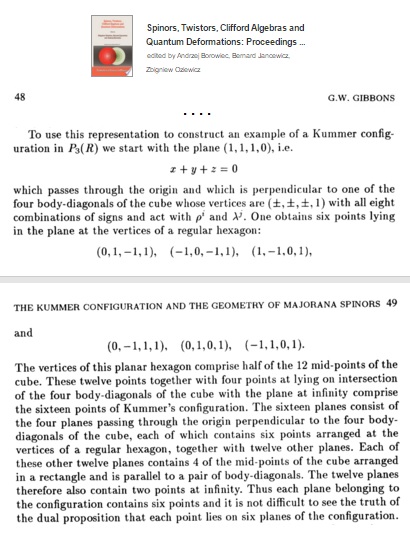
Related material — The Religion of Cubism (May 9, 2003).
Comments Off on Cubism
Saturday, January 2, 2016
From Commentary magazine on Dec. 14, 2015 —
"Three significant American magazines started life in the 1920s.
The American Mercury , founded in 1924, met with the greatest
initial success, in large part because of the formidable reputations
of its editors, H.L. Mencken and George Jean Nathan, and it soon
became the country’s leading journal of opinion."
— Terry Teachout, article on the history of The New Yorker
A search for "American Mercury" in this journal yields a reference from 2003
to a book containing the following passage —
As Webern stated in "The Path to Twelve-Note Composition":
"An example: Beethoven's 'Six easy variations on a Swiss song.'
Theme: C-F-G-A-F-C-G-F, then backwards! You won't notice this
when the piece is played, and perhaps it isn't at all important,
but it is unity ."
— Larry J. Solomon, Symmetry as a Compositional Determinant ,
Chapter 8, "Quadrate Transformations"
This is the Beethoven piece uploaded to YouTube by "Music and such…"
on Dec. 12, 2009. See as well this journal on that same date.
Comments Off on The Beethoven Midrash
Monday, December 21, 2015
A Wikipedia edit today by David Eppstein, a professor
at the University of California, Irvine:

See the Fano-plane page before and after the Eppstein edit.
Eppstein deleted my Dec. 6 Fano 3-space image as well as
today's Fano-plane image. He apparently failed to read the
explanatory notes for both the 3-space model and the
2-space model. The research he refers to was original
(in 1979) but has been published for some time now in the
online Encyclopedia of Mathematics, as he could have
discovered by following a link in the notes for the 3-space
model.
For a related recent display of ignorance, see Hint of Reality.
Happy darkest night.
Comments Off on The Eppstein Edit
Friday, December 18, 2015
Images related to the previous post —


Detail of the 1697 Leibniz medal
|
Leibniz, letter of 1697:
“And so that I won’t come entirely empty-handed this time, I enclose a design of that which I had the pleasure of discussing with you recently. It is in the form of a memorial coin or medallion; and though the design is mediocre and can be improved in accordance with your judgment, the thing is such, that it would be worth showing in silver now and unto future generations, if it were struck at your Highness’s command. Because one of the main points of the Christian Faith, and among those points that have penetrated least into the minds of the worldly-wise and that are difficult to make with the heathen is the creation of all things out of nothing through God’s omnipotence, it might be said that nothing is a better analogy to, or even demonstration of such creation than the origin of numbers as here represented, using only unity and zero or nothing. And it would be difficult to find a better illustration of this secret in nature or philosophy; hence I have set on the medallion design IMAGO CREATIONIS [in the image of creation]. It is no less remarkable that there appears therefrom, not only that God made everything from nothing, but also that everything that He made was good; as we can see here, with our own eyes, in this image of creation. Because instead of there appearing no particular order or pattern, as in the common representation of numbers, there appears here in contrast a wonderful order and harmony which cannot be improved upon….
Such harmonious order and beauty can be seen in the small table on the medallion up to 16 or 17; since for a larger table, say to 32, there is not enough room. One can further see that the disorder, which one imagines in the work of God, is but apparent; that if one looks at the matter with the proper perspective, there appears symmetry, which encourages one more and more to love and praise the wisdom, goodness, and beauty of the highest good, from which all goodness and beauty has flowed.”
|
See also some related posts in this journal.
Comments Off on Box of Nothing
Thursday, December 17, 2015
From an article* in Proceedings of Bridges 2014 —
|
As artists, we are particularly interested in the symmetries of real world physical objects.
Three natural questions arise:
1. Which groups can be represented as the group of symmetries of some real-world physical object?
2. Which groups have actually been represented as the group of symmetries of some real-world physical object?
3. Are there any glaring gaps – small, beautiful groups that should have a physical representation in a symmetric object but up until now have not?
|
The article was cited by Evelyn Lamb in her Scientific American
weblog on May 19, 2014.
The above three questions from the article are relevant to a more
recent (Oct. 24, 2015) remark by Lamb:
"… finite projective planes [in particular, the 7-point Fano plane,
about which Lamb is writing] seem like a triumph of purely
axiomatic thinking over any hint of reality…."
For related hints of reality, see Eightfold Cube in this journal.
* "The Quaternion Group as a Symmetry Group," by Vi Hart and Henry Segerman
Comments Off on Hint of Reality
Friday, December 4, 2015
"Encouraged by Proposition 5, one may hope…."
— Katrin Wendland in the previous post
Related material: Euclid Book I, Proposition 5.
Comments Off on Scholium
Saturday, November 21, 2015
A recent not-too-bright book from Princeton —

Some older, brighter books from Tony Zee —
Fearful Symmetry (1986) and
Quantum Field Theory in a Nutshell (2003).
* Continued.
Comments Off on Brightness at Noon*
Monday, November 9, 2015
"The old, slow art of the eye and the hand, united in service
to the imagination, is in crisis. It’s not that painting is 'dead'
again—no other medium can as yet so directly combine
vision and touch to express what it’s like to have a particular
mind, with its singular troubles and glories, in a particular
body. But painting has lost symbolic force and function in a
culture of promiscuous knowledge and glutting information."
— Peter Schjeldahl in The New Yorker ,
issue dated Jan. 5, 2015
Cover of a 1980 book on computer music that contains a
helpful article on Walsh functions —

See, in this book, "Walsh Functions: A Digital Fourier Series,"
by Benjamin Jacoby (BYTE , September 1977). Some context:
Symmetry of Walsh Functions.
Excerpts from a search for Steve + Jobs in this journal —

Comments Off on A Particular Mind
Wednesday, October 28, 2015

A check of recent tweets by Alexander Bogomolny, who was
mentioned in the previous post, yields a remark of Oct. 26, 2015…

This is not unrelated to a word from Freud:

See as well "Digging Out the Truth?" (Jerusalem Post 2/25/2010)
and Michener's The Source in this journal.
Comments Off on The Tummelplatz of Jerusalem
Sunday, October 25, 2015
(Continued.)
Featured on this morning's online front page of
The New York Times —

Some further details —

An example of New York Times culture is shown above —
"… Mondrian paintings at the Museum of Modern Art
blend symmetry with a tensile volatility."
(To be fair, this contemptible bullshit is from a picture caption,
not from the art review being summarized.)
Related cultural observations —
Math for Child Buyers and Fiction for Child Sellers.
Comments Off on Buyers and Sellers of Children
Saturday, October 10, 2015
Comments Off on Epiphany in Paris
Saturday, August 22, 2015
From Kulturkampf for Princeton (Jan. 14, 2015) —
* Wiig. See Dancer (June 10, 2013). Happy birthday.
Comments Off on A Tony for Kristen*
Sunday, July 26, 2015
"Little emblems of eternity"
— Phrase by Oliver Sacks in today's
New York Times Sunday Review
Some other emblems —

Note the color-interchange
symmetry of each emblem
under 180-degree rotation.
Click an emblem for
some background.
Comments Off on Sunday Sermon
Friday, July 24, 2015
This post was suggested by a book title in
the previous post: "Pieces of the Action."
A group action is a mathematical concept.
Related meditation:
"The number 9, that is to say, relates traditionally
to the Great Goddess of Many Names (Devi,
Inanna, Ishtar, Astarte, Artemis, Venus, etc.)
as matrix of the cosmic process, whether in the
macrocosm or in a microcosmic field of manifestation."
— Joseph Campbell,
The Inner Reaches of Outer Space
Examples:

Click to enlarge —

Comments Off on Field of Manifestation
Sunday, July 19, 2015

See also last night's post.
The above passage was found in a search for thoughts of Heinz Pagels
on "perfect symmetry" (the title of one of his books). The "If all" part is,
however, apparently not by Pagels. That part seems to have been
online only in an NYU file that can no longer be accessed.
For perfect symmetry with structure, see (for instance)
Go Set a Structure (July 14, 2015) and Tombstone (July 16, 2015).
Comments Off on Sunday School
Thursday, July 2, 2015
(Continued from Friday, June 26, 2015)
In memory of an architect —
Donald Wexler, an architect whose innovative steel houses
and soaring glass-fronted terminal at the Palm Springs
International Airport helped make Palm Springs, Calif.,
a showcase for midcentury modernism, died on Friday
[June 26, 2015] at his home in Palm Desert. He was 89.
— William Grimes in this morning's New York Times
For a different sort of architecture in Palm Desert, see…

Comments Off on Deepening the Spielfeld
Monday, May 25, 2015
The most recent version of a passage
quoted in posts tagged "May 19 Gestalt" —
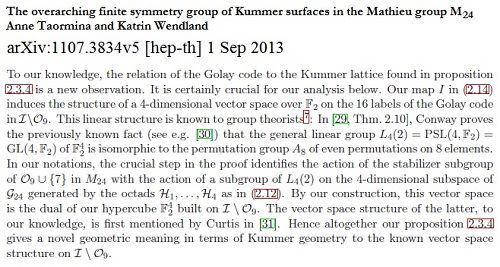
"You've got to pick up every stitch." — Donovan
Comments Off on A Stitch in Time
Sunday, May 17, 2015

"I'm being followed by a moon shadow…." — Song lyric
Comments Off on Moon Shadow
Wednesday, May 13, 2015
Notes on space for day 13 of May, 2015 —
The 13 symmetry axes of the cube may be viewed as
the 13 points of the Galois projective space PG(2,3).
This space (a plane) may also be viewed as the nine points
of the Galois affine space AG(2,3) plus the four points on
an added "line at infinity."
Related poetic material:
The ninefold square and Apollo, as well as …


Comments Off on Space
Tuesday, April 14, 2015
The Dreaming Jewels continued

"… the icosahedron and dodecahedron have the same properties
of symmetry. For the centres of the twenty faces of an icosahedron
may be joined to form a regular dodecahedron, and conversely, the
twelve vertices of an icosahedron can be placed at the centres
of the faces of a suitable dodecahedron. Thus the icosahedral and
dodecahedral groups are identical , and either solid may be used to
examine the nature of the group elements."
— Walter Ledermann, Introduction to the Theory
of Finite Groups (Oliver and Boyd, 1949, p. 93)

Salvador Dali, The Sacrament of the Last Supper

Omar Sharif and Gregory Peck in Behold a Pale Horse

Above: soccer-ball geometry.
See also …


See as well
"In Sunlight and in Shadow."
Comments Off on Sacramental Geometry:
Wednesday, April 1, 2015
The title was suggested by
http://benmarcus.com/smallwork/manifesto/.
The "O" of the title stands for the octahedral group.
See the following, from http://finitegeometry.org/sc/map.html —
|
83-06-21
|
An invariance of symmetry The diamond theorem on a 4x4x4 cube, and a sketch of the proof.
|
|
83-10-01
|
Portrait of O A table of the octahedral group O using the 24 patterns from the 2×2 case of the diamond theorem.
|
|
83-10-16
|
Study of O A different way of looking at the octahedral group, using cubes that illustrate the 2x2x2 case of the diamond theorem.
|
|
84-09-15
|
Diamonds and whirls Block designs of a different sort — graphic figures on cubes. See also the University of Exeter page on the octahedral group O.
|
Comments Off on Manifest O
« Newer Posts —
Older Posts »





































































































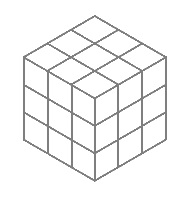




















 .
.







































































